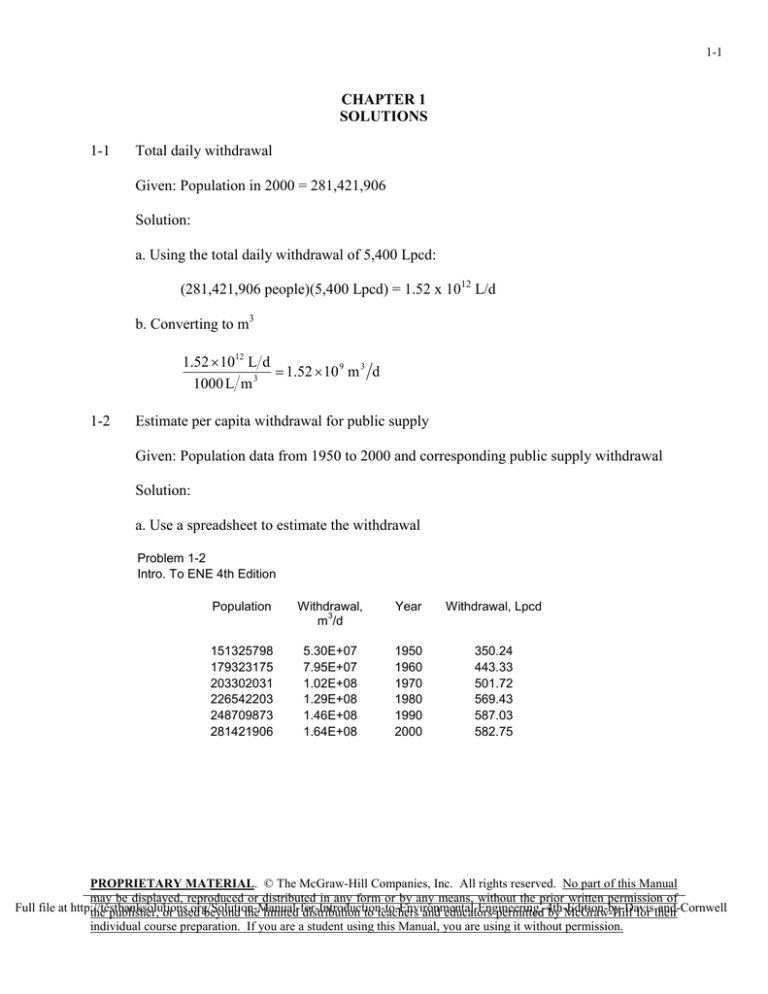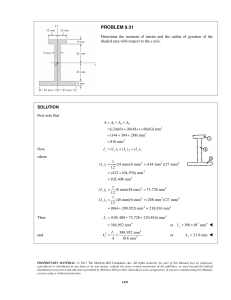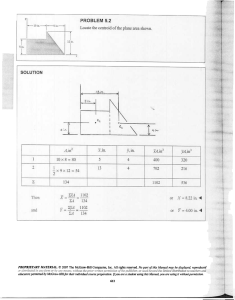
1-1
CHAPTER 1
SOLUTIONS
1-1
Total daily withdrawal
Given: Population in 2000 = 281,421,906
Solution:
a. Using the total daily withdrawal of 5,400 Lpcd:
(281,421,906 people)(5,400 Lpcd) = 1.52 x 1012 L/d
b. Converting to m3
1.52 × 1012 L d
= 1.52 × 10 9 m 3 d
3
1000 L m
1-2
Estimate per capita withdrawal for public supply
Given: Population data from 1950 to 2000 and corresponding public supply withdrawal
Solution:
a. Use a spreadsheet to estimate the withdrawal
Problem 1-2
Intro. To ENE 4th Edition
Population
Withdrawal,
3
m /d
Year
Withdrawal, Lpcd
151325798
179323175
203302031
226542203
248709873
281421906
5.30E+07
7.95E+07
1.02E+08
1.29E+08
1.46E+08
1.64E+08
1950
1960
1970
1980
1990
2000
350.24
443.33
501.72
569.43
587.03
582.75
PROPRIETARY MATERIAL. © The McGraw-Hill Companies, Inc. All rights reserved. No part of this Manual
may be displayed, reproduced or distributed in any form or by any means, without the prior written permission of
Full file at http://testbanksolutions.org/Solution-Manual-for-Introduction-to-Environmental-Engineering,-4th-Edition-by-Davis-and-Cornwell
the publisher, or used beyond the limited distribution to teachers and educators permitted by McGraw-Hill for their
individual course preparation. If you are a student using this Manual, you are using it without permission.
1-2
Liters per capita per day
Problem 1-2:Per Capita Daily Water
Withdrawal for Public Supply
650.00
600.00
550.00
500.00
450.00
400.00
350.00
300.00
250.00
200.00
150.00
100.00
50.00
0.00
Estimated = 575 Lpcd
1940 1950 1960 1970 1980 1990 2000 2010
Year
Figure S-1-2: Per capita daily water withdrawal
1-3
Additional average daily water production required
Given: 280 houses and, from text: 1,320 L/d - house
Solution:
(280 houses)(1,320 L/d - house) = 3.7 x 105 L/d
PROPRIETARY MATERIAL. © The McGraw-Hill Companies, Inc. All rights reserved. No part of this Manual
may be displayed, reproduced or distributed in any form or by any means, without the prior written permission of
Full file at http://testbanksolutions.org/Solution-Manual-for-Introduction-to-Environmental-Engineering,-4th-Edition-by-Davis-and-Cornwell
the publisher, or used beyond the limited distribution to teachers and educators permitted by McGraw-Hill for their
individual course preparation. If you are a student using this Manual, you are using it without permission.
1-3
1-4
Additional average water production required with low-flush toilets
Given: 320 houses that have low flush valves that reduce water consumption by 14%
and, from text, 1,320 L/d - house
Solution:
Additional demand = (320 houses)(1,320 L/d - house)(1 – 0.14) = 3.18 x 105 L/d
1-5
Repeat Prob. 1-3 for peak demand
Given: 280 metered houses, AWWA average
Solution:
a. From text: peak hour = 5.3(avg. day)
(5.3)(280 houses)(1,320 L/d - house) = 1.96 x 106 or 2 x 106 L/d at the peak hour
1-6
Water lost (in liters) in one year
Given: One drop per second, 0.150 mL per drop
Solution:
(0.150 mL/s)(86,400 s/d)(365 d/y)(1 x 10-3 L/mL) = 4,730 L/y
1-7
Monthly cost of not repairing valve
Given: Valves deliver 130.0 L/min, Water cost = $0.45 per cubic meter
Solution:
a. Assuming 30 d/mo
(130.0 L/min)(1440 min/d)(30 d/mo)(1 x 10-3 m3/L) = 5,616 m3/mo
(5,616 m3/mo)($0.45/m3) = $2,527.20 or $2,530/mo
1-8
Value of water lost
Given: Year 2000 data from Prob. 1-2, 15% water loss, cost of water = $0.45/m3
Solution:
PROPRIETARY MATERIAL. © The McGraw-Hill Companies, Inc. All rights reserved. No part of this Manual
may be displayed, reproduced or distributed in any form or by any means, without the prior written permission of
Full file at http://testbanksolutions.org/Solution-Manual-for-Introduction-to-Environmental-Engineering,-4th-Edition-by-Davis-and-Cornwell
the publisher, or used beyond the limited distribution to teachers and educators permitted by McGraw-Hill for their
individual course preparation. If you are a student using this Manual, you are using it without permission.
1-4
a. Amount of water lost
(1.6 x 108 m3/d)(0.15) = 2.4 x 107 m3/d
b. Value
(2.4 x 107 m3/d)($0.45/m3) = $1.08 x 107 or $1.1 x 107/d
1-9
Cost of bottled water
Given: 0.5 L bottle of water costs $1.00
Solution:
a. Convert L to m3
0 .5 L
= 0.0005 or 5.0 x 10-4 m3
3
1000 L m
b. Cost
$1.00
= $2 × 10 3 or $2000/m3
−4
3
5.0 × 10 m
1-10
Daily per capita withdrawal for South Carolina
Given: USGS circular 1268 at /usgs.gov
Solution:
a. From the web site
Domestic withdrawal for SC = 63.5 x 106 gal/d
Population = 4,010 x 103
b. Per capita
63.5 × 10 6 gal d
= 59.94 or Lpcd
4010 × 10 3 people (0.2642 gal L )
(
)
PROPRIETARY MATERIAL. © The McGraw-Hill Companies, Inc. All rights reserved. No part of this Manual
may be displayed, reproduced or distributed in any form or by any means, without the prior written permission of
Full file at http://testbanksolutions.org/Solution-Manual-for-Introduction-to-Environmental-Engineering,-4th-Edition-by-Davis-and-Cornwell
the publisher, or used beyond the limited distribution to teachers and educators permitted by McGraw-Hill for their
individual course preparation. If you are a student using this Manual, you are using it without permission.
1-5
1-11
Lowest domestic withdrawal in the world
Given: Pacific Institute web site (www.worldwater.org/table2.html)
Solution:
a. From the web site column labeled “Domestic Use” in m3/p/y
Gambia and Haiti tied at 1 m3/person – y
b. Convert to Lpcd
(1 m
3
)(
)
person ⋅ y 1000 L m 3
= 2.74 or 3 Lpcd
365 d y
PROPRIETARY MATERIAL. © The McGraw-Hill Companies, Inc. All rights reserved. No part of this Manual
may be displayed, reproduced or distributed in any form or by any means, without the prior written permission of
Full file at http://testbanksolutions.org/Solution-Manual-for-Introduction-to-Environmental-Engineering,-4th-Edition-by-Davis-and-Cornwell
the publisher, or used beyond the limited distribution to teachers and educators permitted by McGraw-Hill for their
individual course preparation. If you are a student using this Manual, you are using it without permission.
1-6
DISCUSSION QUESTIONS
1-1
Effect of price on demand
Given: Doubling of price of water
Solution:
In the U.S. the price of water does not severely affect the demand because water is so
cheap. Doubling of the price would reduce the demand but it would not drop in half.
1-2
Type of water treatment
Given: water is from wells and proposed treatment is filtration. NOTE: it is assumed that
the well water is either hard or has a high iron content.
Solution:
The answer is False.
The revised statement is: A softening plant or iron removal plant would be appropriate to
improve the quality of the water.
1-3
Water pressure problems
Given: Gettysburg, PA has difficulty in supplying water over 4th of July weekend but not
other times of year.
Solution:
Because of its historical significance, thousands of tourists descend on Gettysburg on the
4th of July weekend. The visitors use a large quantity of water before and after their
sightseeing tours. The large demand exceeds the systems capacity to maintain the
pressure in the system. This may be because of the lack of adequate storage, the small
capacity of the water treatment plant, or the large pressure drops due to friction in the
distribution system, or some combination of the three.
1-4
Recommended plan for a new water treatment plant
Given: Average daily demand = 11,400 m3/d. Proposal A is for 475 m3/h and 2,500 m3 of
storage. Proposal B is for 1,080 m3/h and no storage.
Solution:
Proposal A is preferred for several reasons. First, the 475 m3/h will meet the average
PROPRIETARY MATERIAL. © The McGraw-Hill Companies, Inc. All rights reserved. No part of this Manual
may be displayed, reproduced or distributed in any form or by any means, without the prior written permission of
Full file at http://testbanksolutions.org/Solution-Manual-for-Introduction-to-Environmental-Engineering,-4th-Edition-by-Davis-and-Cornwell
the publisher, or used beyond the limited distribution to teachers and educators permitted by McGraw-Hill for their
individual course preparation. If you are a student using this Manual, you are using it without permission.
1-7
daily demand of 11,400 m3/d (475 m3/h x 24 h/d = 11,400 m3/d). Second, the 2,500 m3
of storage will provide a reserve capacity equal to the maximum hour (5.3 times the
average day). Third, the smaller plant will be more economical to build.
Proposal B will not be able to meet the maximum hour demand (5.3 x 475 m3/h = 2,520
m3/h) and will, on the average, be over designed for capacity and, thus, not be
economical to build.
1-5
Infiltration & Inflow
Given: Homeowners have connected downspouts and sump pumps to sanitary sewer.
Solution:
The water entering the sewer is called inflow. (Choice = (b).)
These connections, in effect, make the sanitary sewer a combined sewer. (Choice = (d).)
1-6
Shiny Plating Co. ethics problem
Given: Long ethics problem dealing with the Shiny Plating Co.
Solution:
In the interest of waste minimization, the company should install the pollution control
equipment. The two year payback is reasonable. "Lack of capital and high interest
rates," are common excuses for not installing control equipment. The short payback time
is indicative of long term profitability of the control device.
1-7
Leather tannery ethics problem
Given: Long ethics problem dealing with leather tannery.
Solution:
Select answer A. The discharge was illegal and not reporting is likewise illegal. Both
professional ethics and environmental ethics require this choice.
PROPRIETARY MATERIAL. © The McGraw-Hill Companies, Inc. All rights reserved. No part of this Manual
may be displayed, reproduced or distributed in any form or by any means, without the prior written permission of
Full file at http://testbanksolutions.org/Solution-Manual-for-Introduction-to-Environmental-Engineering,-4th-Edition-by-Davis-and-Cornwell
the publisher, or used beyond the limited distribution to teachers and educators permitted by McGraw-Hill for their
individual course preparation. If you are a student using this Manual, you are using it without permission.





